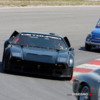I would like to make a stroker for my Pantera. It has to be a really driveable engine for track use and to be reliable. 500-550 bhp is more than enough. I was thinking of a modest stroke like 377 or 393 reving it till a max of 7500 rpm. I hope that with the car weight and stock transaxle this will be a good option.
In your postings on the web you say that it is no use to get a complete kit.
" Most of the kits sold are simply pieced together by retailers who don't actually build engines. They slap some parts together and hope it all fits. I've seen these sorts of problems from genetic retailers,Ford specialists, and eventhe manufactuers themselves, including SCAT who I've to educate concerning the differences between 351C's and 351W's DAN JONES "
" When shopping around for a stroker kit, there are a number of things to keep in mind. first of all, there is little reason to buy a kit. DAN JONES "
Now this was 4 years ago. Did the manufactuers improve their products? Is it reasonal now to buy a Ford small block 4340 superlight forged rotating assembly from SCAT, or is it wise to shop around?
The other question is, in your opinion would you go for 377 with 3v heads or 393 with 4v heads, or even a 393 with 3v heads. Or even something completely different. It is a little to expensive to go and try them all, that is why I would use a bid of your experience. As said I am not looking for the biggest or strongest engine around, but the engine with the highest driveability and practability.
Rgds Arno
ps. if Dan Jones does not reply does somebody know how to contact him?
Attachments
Original Post


